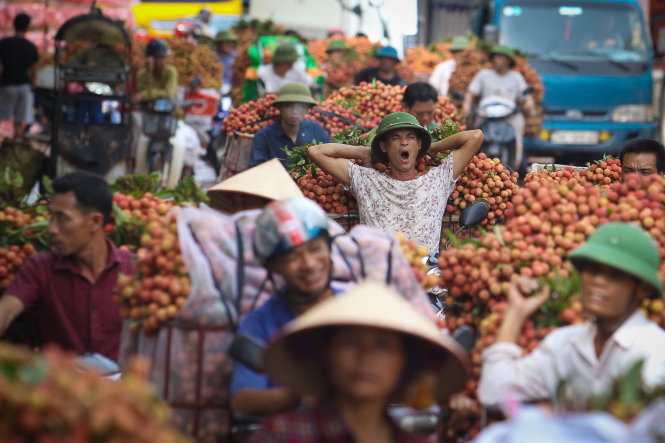Just like in previous years, lychee growers in Vietnam have been on edge in the past few weeks, being uncertain of what is in store for them regarding crop earnings this year.
The two largest lychee-growing areas in the country lie in Bac Giang and Hai Duong Provinces in the north.
Growers in the two provinces are expecting to harvest a total of 200,000 metric tons of fresh lychees in the 2015 crop, a 28.2 percent year on year rise, according to the Vietnam Trade Promotion Agency.
According to the Vietnamese Ministry of Industry and Trade, about 60 percent of the lychees, or 120,000 metric tons, will be sold domestically, while the remaining 40 percent, or 80,000 metric tons, including 85 percent of fresh fruits and 15 percent of dried and frozen fruits, are set aside for export to a number of foreign markets like Laos, Cambodia, Thailand, Singapore, the U.S., Australia, Japan, South Korea, and Europe.

Workers are pictured shuttling between huge freights of lychees. Photo: Tuoi Tre
Over the past few weeks, growers in Luc Ngan District, a lychee ‘hotpot’ in Bac Giang, have had their hands full reaping their fruits to make sure they are harvested in their prime time – which lasts only three or four weeks – and fetch the highest possible prices.
The farmers are also fraught with worries over how much they will earn from this year’s crops, as lychees tend to fetch unpredictable prices.
On a recent day in the district’s Phuong Son Commune, home to one of the province’s largest lychee ‘trading floors,’ some hundred fretted growers were seen on their bikes, with large baskets of lychees behind their backs.
They queued up waiting for their turn to have their loads weighed by traders.
“Prices fluctuate notably depending on farmers, areas, and when the fruits are purchased. My lychees were priced VND14,000 [US$0.7] per kilogram this morning, but they are likely to drop to a mere VND8,000 per kilogram this afternoon,” Tran Van Hai, a grower, lamented.
He was carrying a bulky lychee load of some 100 kilograms for the sale.
Traders generally garner loads in the morning before packaging and selling them during the day, which results in lower prices in the afternoon.

A Chinese trader (first right) is pictured during a bargain with a Vietnamese lychee grower. Traders purchase some three to five metric tons of quality, nice-looking fruits at one go. Photo: Tuoi Tre
Nguyen Van Quan, a grower in the province’s Lang Giang District, told Tuoi Tre (Youth) newspaper that production costs amount to around VND2.5 million ($115) per metric ton of lychees that he sells.
Dao Xuan Con, another farmer who owns a one-hectare plot of lychee plants in the province’s Luc Nam District, said the produce in its early harvest phase goes for lower prices than those last year.
The fruits fetch between VND12,000 ($0.6) and VND18,000 ($0.8) per kilogram depending on their quality, while those falling off their plants are sold for merely VND4,000 ($0.2) per kilogram, Con said.
Lychees, which boast reddish skin, irresistibly sweet whitish translucent pulp and are eaten fresh or dried, sell for between VND20,000 ($1) and VND85,000 ($4) each kilogram, which depends on their quality and where they are displayed for sale – at supermarkets, shops selling specialties from the northern region, or on sidewalks.
“My entire family members have been mobilized for the harvest in the past few days, as the prices will drop considerably in one week’s time. I really hope my produce will be purchased by a company and has a stable market, so that traders can no longer impose low rates on my fruits,” Con added.

Bunches of fresh lychees are ready to make their way to consumers. Photo: Tuoi Tre

A young man transports his freight of lychees to a market under the rain. Photo: Tuoi Tre

A woman’s burdensome freight of lychees knocked her bike and herself over. Photo: Tuoi Tre

Dao Xuan Con, a farmer who owns a one-hectare plot of lychee plants in Luc Nam District in Bac Giang Province, and his family waste no time reaping their yields. Photo: Tuoi Tre

Lychees are washed and dipped in iced water before being packaged and destined for the southern region for consumption. The fruit typically thrives in the northern region’s temperate climate. Photo: Tuoi Tre

Farmers are pictured with their bulky freights of lychees behind during a rain which may easily render the fruits rotten. Photo: Tuoi Tre
Like us on Facebook or follow us on Twitter to get the latest news about Vietnam!


















































